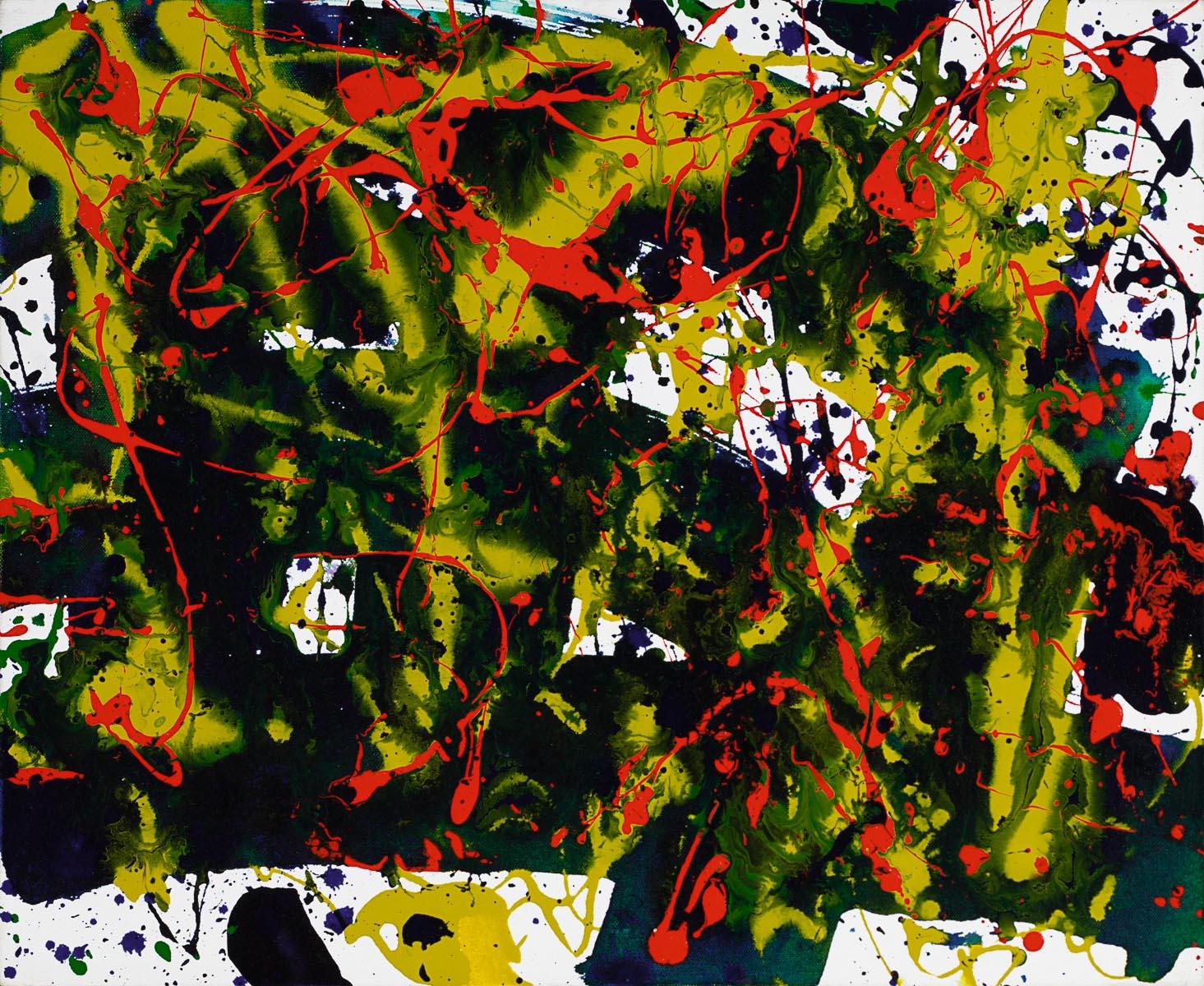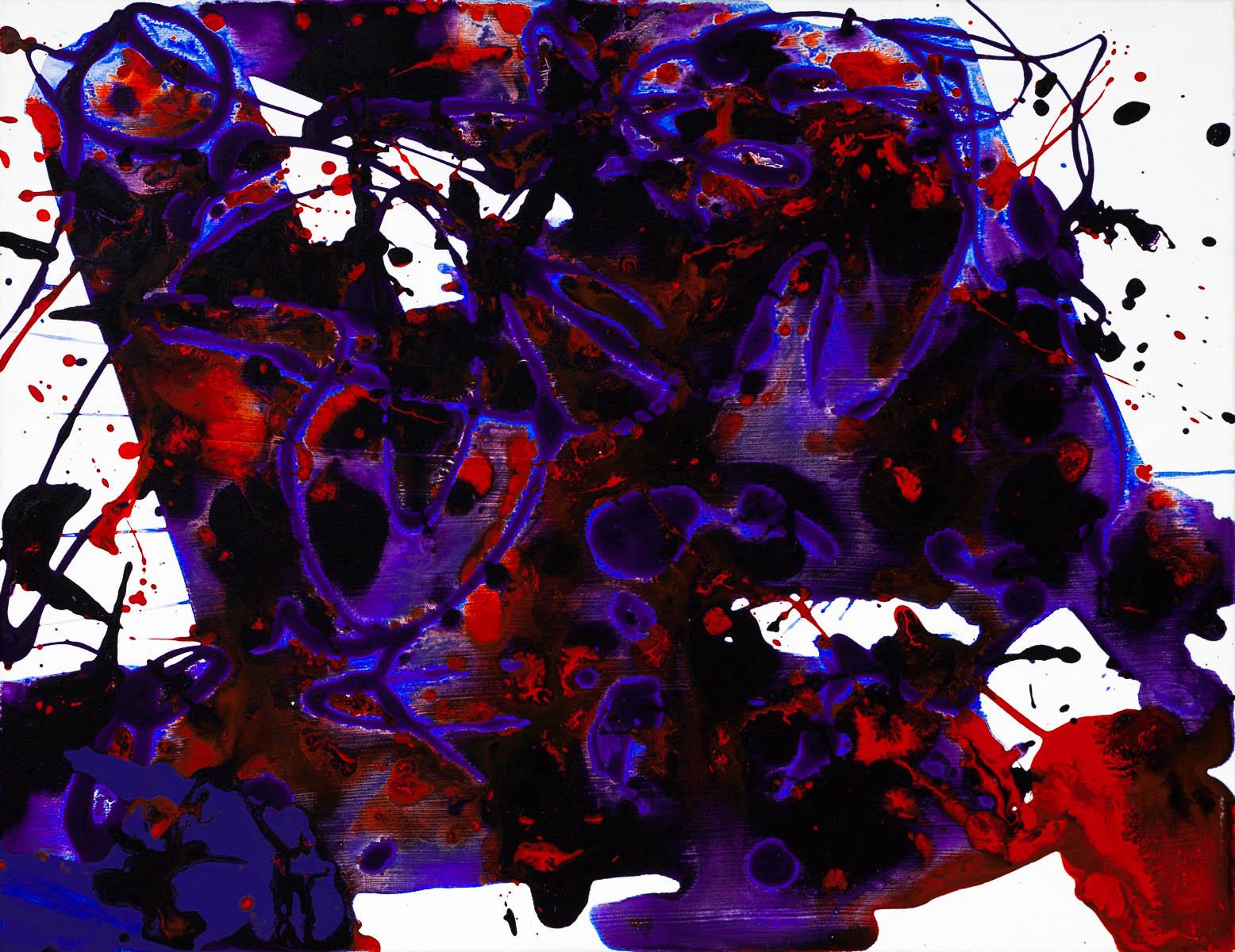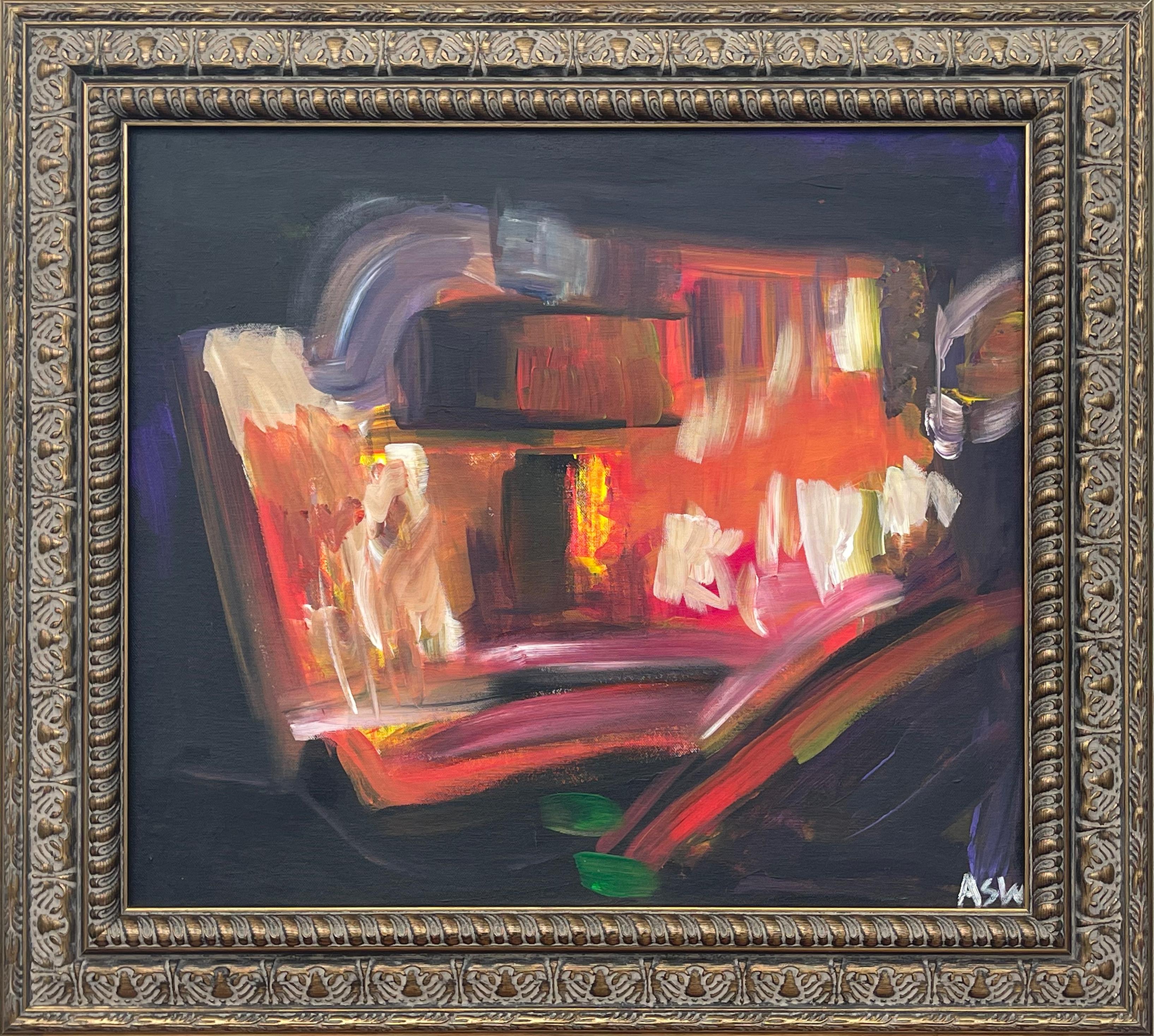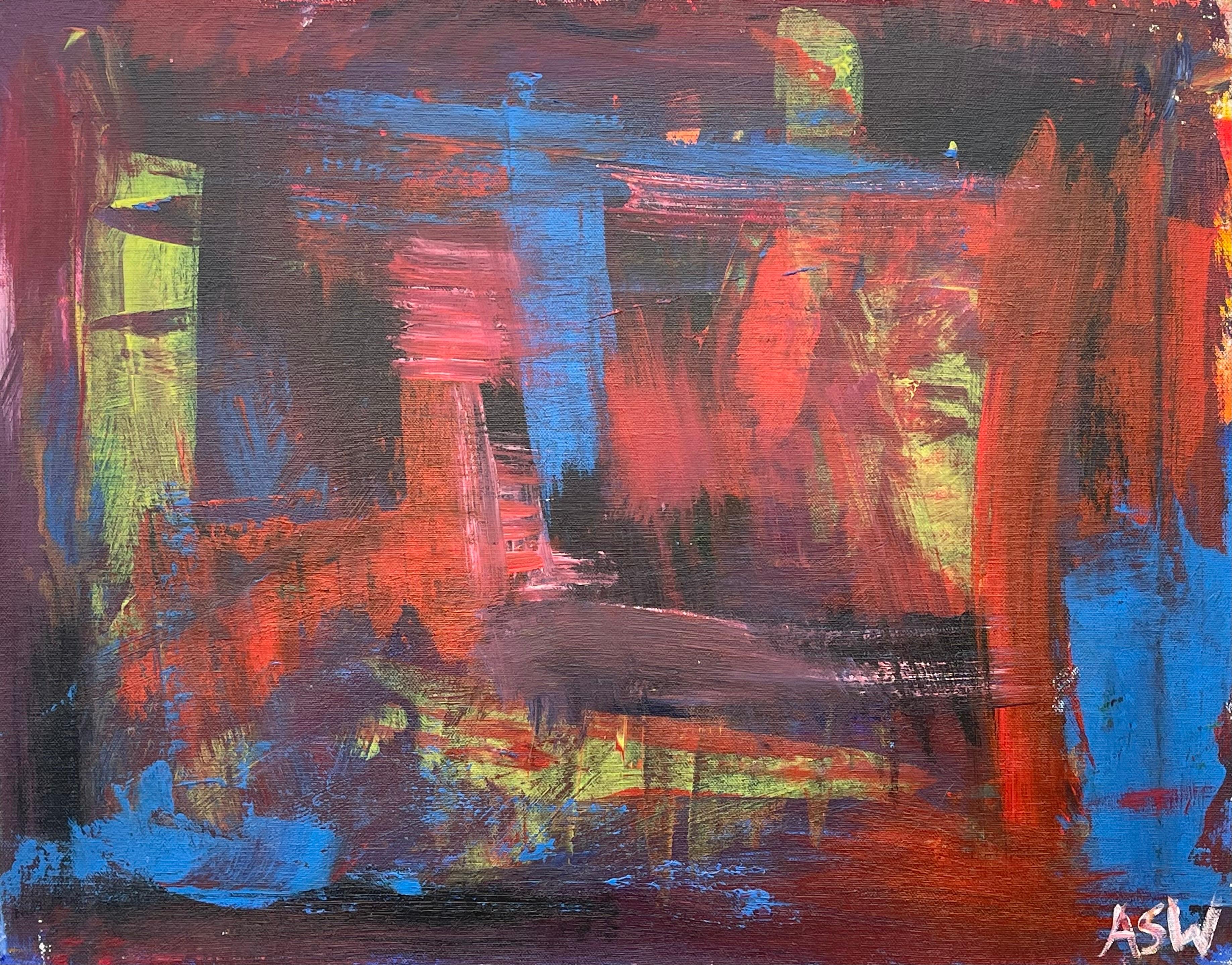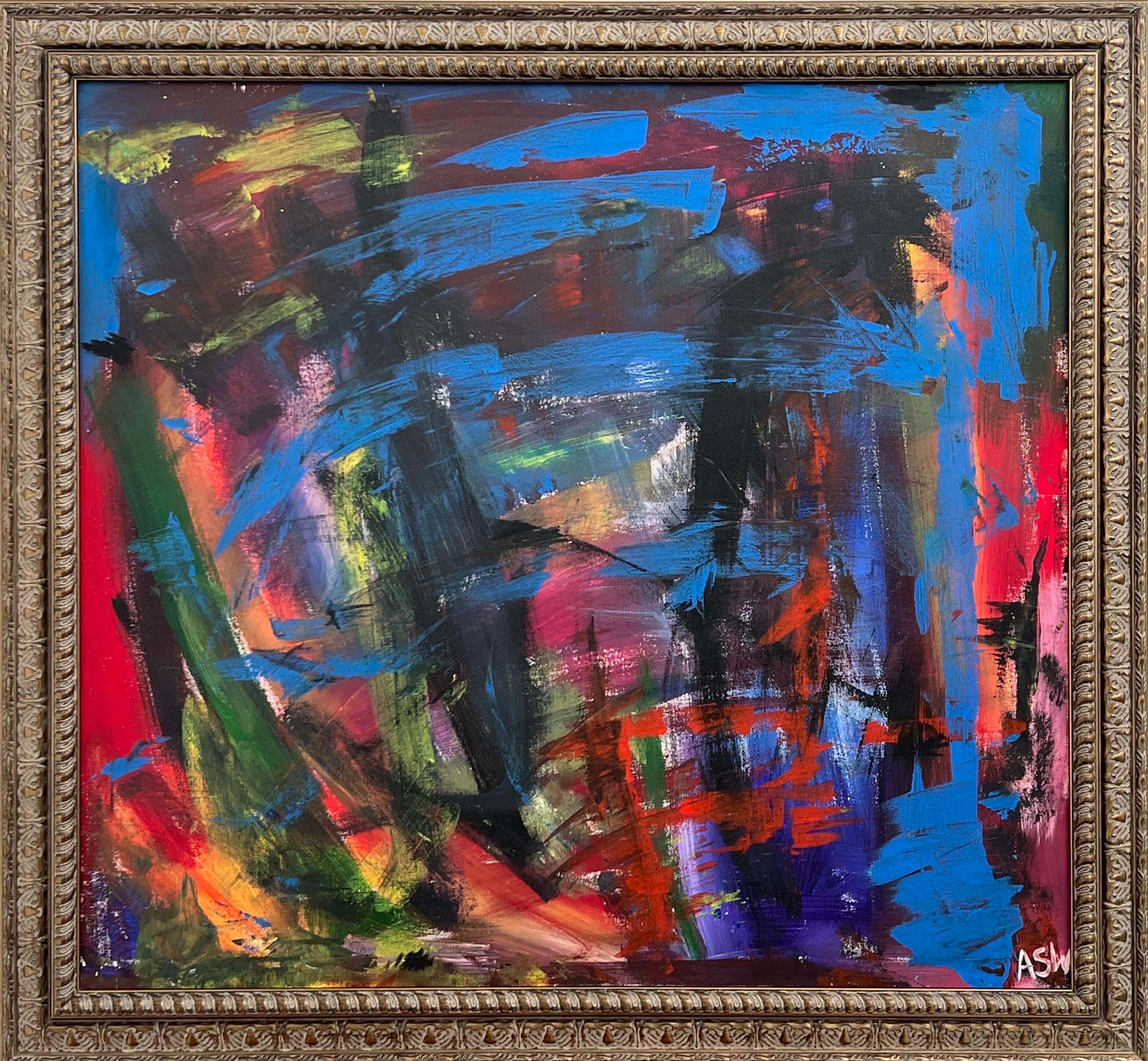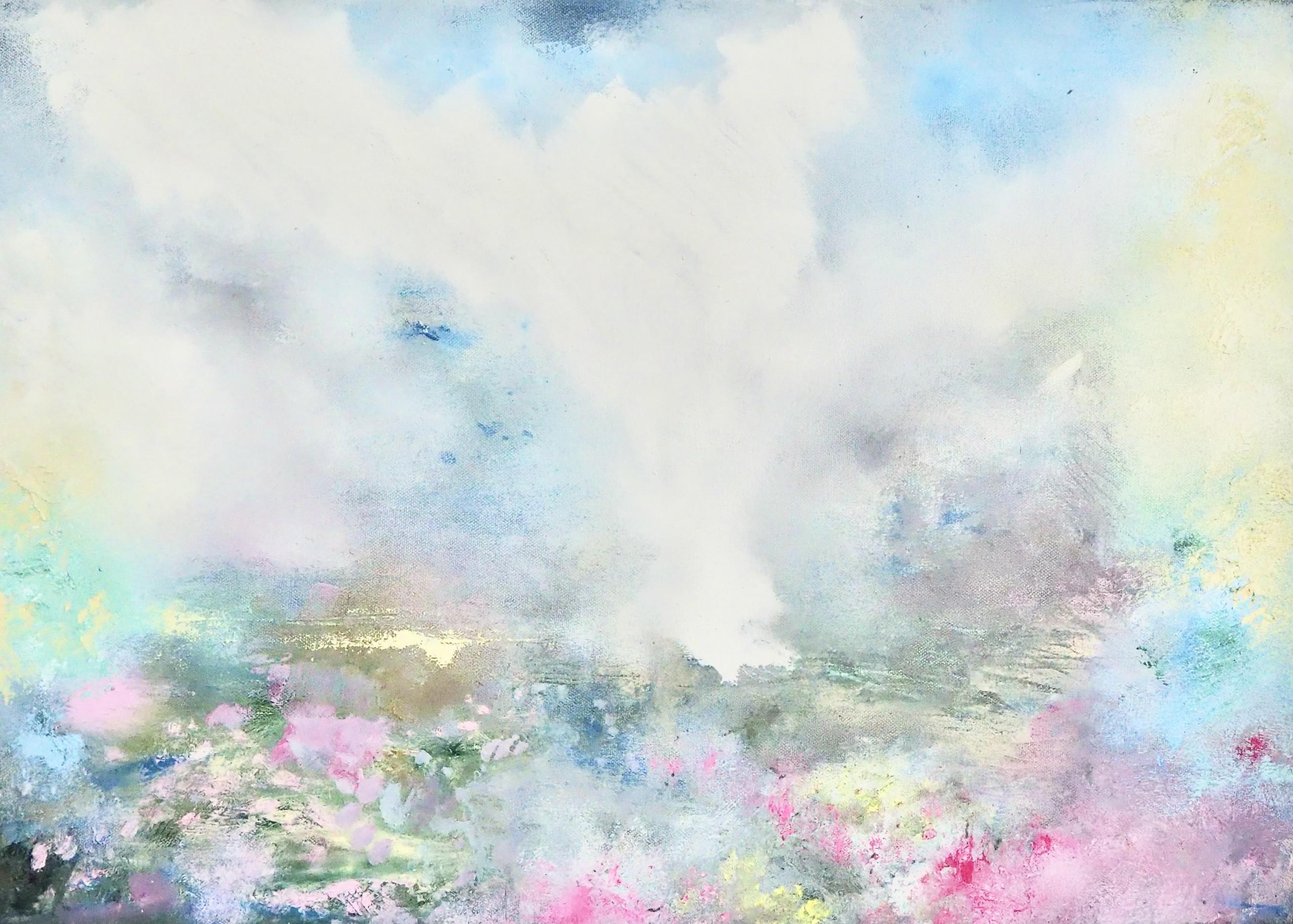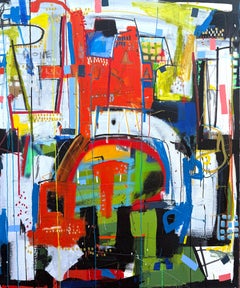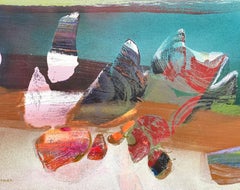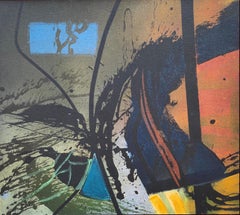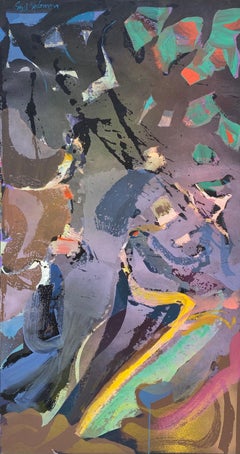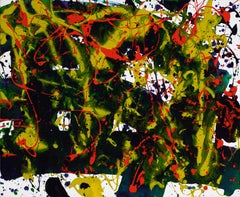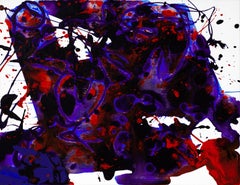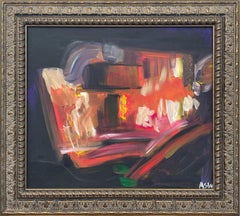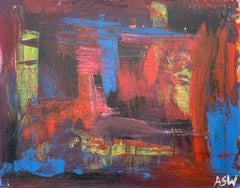Items Similar to “Untitled”
Want more images or videos?
Request additional images or videos from the seller
1 of 8
“Untitled”Circa 2012
Circa 2012
About the Item
Original acrylic on canvas painting mounted on white lucite and framed in white Larsen Juhl custom frame. Untitled. No visible signature. Attributed to Joseph Conrad Ferm. Originally purchased from the artist. Condition is excellent. Overall framed measurements are 96.75 by 19.75 inches. May be hung vertically or horizontally. Provenance: a Southampton, New York gentleman.
Joseph Conrad-Ferm
Joseph Conrad-Ferm is a self taught painter who did not discover his need to paint until age 26. With over 1,000 finished works on paper, canvas, and wood, Ferm's paintings are in public and private collections worldwide. His work is extensively used by interior designers and has been featured in design publications in the US. He currently resides in Cape Cod, MA.
- Attributed to:Joseph Conrad Ferm (American)
- Creation Year:Circa 2012
- Dimensions:Height: 82 in (208.28 cm)Width: 16 in (40.64 cm)Depth: 1.5 in (3.81 cm)
- Medium:
- Movement & Style:
- Period:
- Condition:
- Gallery Location:Southampton, NY
- Reference Number:1stDibs: LU14115492722
About the Seller
5.0
Platinum Seller
Premium sellers with a 4.7+ rating and 24-hour response times
Established in 1977
1stDibs seller since 2013
525 sales on 1stDibs
Typical response time: 1 hour
- ShippingRetrieving quote...Shipping from: Southampton, NY
- Return Policy
Authenticity Guarantee
In the unlikely event there’s an issue with an item’s authenticity, contact us within 1 year for a full refund. DetailsMoney-Back Guarantee
If your item is not as described, is damaged in transit, or does not arrive, contact us within 7 days for a full refund. Details24-Hour Cancellation
You have a 24-hour grace period in which to reconsider your purchase, with no questions asked.Vetted Professional Sellers
Our world-class sellers must adhere to strict standards for service and quality, maintaining the integrity of our listings.Price-Match Guarantee
If you find that a seller listed the same item for a lower price elsewhere, we’ll match it.Trusted Global Delivery
Our best-in-class carrier network provides specialized shipping options worldwide, including custom delivery.More From This Seller
View All“Domane”
Located in Southampton, NY
Original large original acrylic on canvas abstract painting by the well known American artist, Joseph Conrad Ferm. Condition is very good. Signed top right “Ferm”. Titled, signed a...
Category
2010s Abstract Expressionist Abstract Paintings
Materials
Canvas, Acrylic
“Sandscape 2”
By Syd Solomon
Located in Southampton, NY
Original oil and acrylic painting on canvas titled “Sandscape 2” by the well known American artist, Syd Solomon. Signed Syd Solomon lower left. Signed and dated Syd Solomon 1972 and inscribed as titled on the reverse. 22 × 30 inches. Overall very good to excellent condition. No notable issues detected during inspection. No signs of restoration under UV inspection. The painting is in its original wood with silver reveal floating frame. Overall framed measurements are 24.25 by 32.25 inches. Provenance: A private collector.
Syd Solomon was born near Uniontown, Pennsylvania, in 1917. He began painting in high school in Wilkes-Barre, where he was also a star football player. After high school, he worked in advertising and took classes at the Art Institute of Chicago. Before the attack on Pearl Harbor, he joined the war effort and was assigned to the First Camouflage Battalion, the 924th Engineer Aviation Regiment of the US Army. He used his artistic skills to create camouflage instruction manuals utilized throughout the Army. He married Ann Francine Cohen in late 1941. Soon thereafter, in early 1942, the couple moved to Fort Ord in California where he was sent to camouflage the coast to protect it from possible aerial bombings. Sent overseas in 1943, Solomon did aerial reconnaissance over Holland. Solomon was sent to Normandy early in the invasion where his camouflage designs provided protective concealment for the transport of supplies for men who had broken through the enemy line. Solomon was considered one of the best camoufleurs in the Army, receiving among other commendations, five bronze stars. Solomon often remarked that his camouflage experience during World War II influenced his ideas about abstract art. At the end of the War, he attended the École des Beaux-Arts in Paris.
Because Solomon suffered frostbite during the Battle of the Bulge, he could not live in cold climates, so he and Annie chose to settle in Sarasota, Florida, after the War. Sarasota was home to the John and Mable Ringling Museum of Art, and soon Solomon became friends with Arthur Everett “Chick” Austin, Jr., the museum’s first Director. In the late 1940s, Solomon experimented with new synthetic media, the precursors to acrylic paints provided to him by chemist Guy Pascal, who was developing them. Victor D’Amico, the first Director of Education for the Museum of Modern Art, recognized Solomon as the first artist to use acrylic paint. His early experimentation with this medium as well as other media put him at the forefront of technical innovations in his generation. He was also one of the first artists to use aerosol sprays and combined them with resists, an innovation influenced by his camouflage experience.
Solomon’s work began to be acknowledged nationally in 1952. He was included in American Watercolors, Drawings and Prints at the Metropolitan Museum of Art, New York. From 1952–1962, Solomon’s work was discovered by the cognoscenti of the art world, including the Museum of Modern Art Curators, Dorothy C. Miller and Peter Selz, and the Whitney Museum of American Art’s Director, John I. H. Baur. He had his first solo show in New York at the Associated American Artists Gallery in 1955 with “Chick” Austin, Jr. writing the essay for the exhibition. In the summer of 1955, the Solomons visited East Hampton, New York, for the first time at the invitation of fellow artist David Budd. There, Solomon met and befriended many of the artists of the New York School, including Jackson Pollock, Franz Kline, Willem de Kooning, James Brooks, Alfonso Ossorio, and Conrad Marca-Relli. By 1959, and for the next thirty-five years, the Solomons split the year between Sarasota (in the winter and spring) and the Hamptons (in the summer and fall).
In 1959, Solomon began showing regularly in New York City at the Saidenberg Gallery with collector Joseph Hirshhorn buying three paintings from Solomon’s first show. At the same time, his works entered the collections of the Whitney Museum of American Art, the Solomon R. Guggenheim Museum, and the Wadsworth Athenaeum in Hartford, Connecticut, among others. Solomon also began showing at Signa Gallery in East Hampton and at the James David Gallery in Miami run by the renowned art dealer, Dorothy Blau.
In 1961, the Guggenheim Museum’s H. H. Arnason bestowed to him the Silvermine Award at the 13th New England Annual. Additionally, Thomas Hess of ARTnews magazine chose Solomon as one of the ten outstanding painters of the year. At the suggestion of Alfred H. Barr, Jr., the Museum of Modern Art’s Director, the John and Mable Ringling Museum in Sarasota began its contemporary collection by purchasing Solomon’s painting, Silent World, 1961.
Solomon became influential in the Hamptons and in Florida during the 1960s. In late 1964, he created the Institute of Fine Art at the New College in Sarasota. He is credited with bringing many nationally known artists to Florida to teach, including Larry Rivers, Philip Guston, James Brooks, and Conrad Marca-Relli. Later Jimmy Ernst, John Chamberlain, James Rosenquist, and Robert Rauschenberg settled near Solomon in Florida. In East Hampton, the Solomon home was the epicenter of artists and writers who spent time in the Hamptons, including Alfred Leslie, Jim Dine, Ibram Lassaw, Saul Bellow, Barney Rosset, Arthur Kopit, and Harold Rosenberg.
In 1970, Solomon, along with architect Gene Leedy, one of the founders of the Sarasota School of Architecture, built an award-winning precast concrete and glass house and studio on the Gulf of Mexico near Midnight Pass in Sarasota. Because of its siting, it functioned much like Monet’s home in Giverny, France. Open to the sky, sea, and shore with inside and outside studios, Solomon was able to fully solicit all the environmental forces that influenced his work. His friend, the art critic Harold Rosenberg, said Solomon’s best work was produced in the period he lived on the beach.
During 1974 and 1975, a retrospective exhibition of Solomon’s work was held at the New York Cultural Center and traveled to the John and Mable Ringling Museum in Sarasota. Writer Kurt Vonnegut, Jr. conducted an important interview with Solomon for the exhibition catalogue. The artist was close to many writers, including Harold Rosenberg, Joy Williams, John D. McDonald, Budd Schulberg, Elia Kazan, Betty Friedan...
Category
1970s Abstract Expressionist Abstract Paintings
Materials
Acrylic, Oil, Canvas
“Gulfside”
By Syd Solomon
Located in Southampton, NY
Original, oil paint and acrylic paint on canvas by the well known American artist, Syd Solomon. Signed bottom middle by the artist. Titled and dated verso 1983. Condition is excellent. Original gallery floating frame. Overall framed measurements are 38 by 42 inches. Provenance: A Sarasota, Florida collector.
SYD SOLOMON BIOGRAPHY
Written by Dr. Lisa Peters/Berry Campbell Gallery
“Here, in simple English, is what Syd Solomon does: He meditates. He connects his hand and paintbrush to the deeper, quieter, more mysterious parts of his mind- and he paints pictures of what he sees and feels down there.”
--Kurt Vonnegut Jr. from Palm Sunday, 1981
Syd Solomon was born near Uniontown, Pennsylvania, in 1917. He began painting in high school in Wilkes-Barre, where he was also a star football player. After high school, he worked in advertising and took classes at the Art Institute of Chicago. Before the attack on Pearl Harbor, he joined the war effort and was assigned to the First Camouflage Battalion, the 924th Engineer Aviation Regiment of the US Army. He used his artistic skills to create camouflage instruction manuals utilized throughout the Army. He married Ann Francine Cohen in late 1941. Soon thereafter, in early 1942, the couple moved to Fort Ord in California where he was sent to camouflage the coast to protect it from possible aerial bombings. Sent overseas in 1943, Solomon did aerial reconnaissance over Holland. Solomon was sent to Normandy early in the invasion where his camouflage designs provided protective concealment for the transport of supplies for men who had broken through the enemy line. Solomon was considered one of the best camoufleurs in the Army, receiving among other commendations, five bronze stars. Solomon often remarked that his camouflage experience during World War II influenced his ideas about abstract art. At the end of the War, he attended the École des Beaux-Arts in Paris.
Because Solomon suffered frostbite during the Battle of the Bulge, he could not live in cold climates, so he and Annie chose to settle in Sarasota, Florida, after the War. Sarasota was home to the John and Mable Ringling Museum of Art, and soon Solomon became friends with Arthur Everett “Chick” Austin, Jr., the museum’s first Director. In the late 1940s, Solomon experimented with new synthetic media, the precursors to acrylic paints provided to him by chemist Guy Pascal, who was developing them. Victor D’Amico, the first Director of Education for the Museum of Modern Art, recognized Solomon as the first artist to use acrylic paint. His early experimentation with this medium as well as other media put him at the forefront of technical innovations in his generation. He was also one of the first artists to use aerosol sprays and combined them with resists, an innovation influenced by his camouflage experience.
Solomon’s work began to be acknowledged nationally in 1952. He was included in American Watercolors, Drawings and Prints at the Metropolitan Museum of Art, New York. From 1952–1962, Solomon’s work was discovered by the cognoscenti of the art world, including the Museum of Modern Art Curators, Dorothy C. Miller and Peter Selz, and the Whitney Museum of American Art’s Director, John I. H. Baur. He had his first solo show in New York at the Associated American Artists Gallery in 1955 with “Chick” Austin, Jr. writing the essay for the exhibition. In the summer of 1955, the Solomons visited East Hampton, New York, for the first time at the invitation of fellow artist David Budd...
Category
1980s Abstract Expressionist Abstract Paintings
Materials
Canvas, Oil, Acrylic
$36,000
“Lightride”
By Syd Solomon
Located in Southampton, NY
Here for your consideration is a great example of the artwork of the well known American artist, Syd Solomon. Signed top left. Titled and dated verso 1978. The painting is oil and acrylic paint on mounted synthetic canvas. Condition is excellent. Overall framed measurements are 44.75 by 24.5 inches. Provenance: A Sarasota, Florida collector.
SYD SOLOMON BIOGRAPHY American 1917-2004
Written by Dr. Lisa Peters/Berry Campbell Gallery
“Here, in simple English, is what Syd Solomon does: He meditates. He connects his hand and paintbrush to the deeper, quieter, more mysterious parts of his mind- and he paints pictures of what he sees and feels down there.”
--Kurt Vonnegut Jr. from Palm Sunday, 1981
Syd Solomon was born near Uniontown, Pennsylvania, in 1917. He began painting in high school in Wilkes-Barre, where he was also a star football player. After high school, he worked in advertising and took classes at the Art Institute of Chicago. Before the attack on Pearl Harbor, he joined the war effort and was assigned to the First Camouflage Battalion, the 924th Engineer Aviation Regiment of the US Army. He used his artistic skills to create camouflage instruction manuals utilized throughout the Army. He married Ann Francine Cohen in late 1941. Soon thereafter, in early 1942, the couple moved to Fort Ord in California where he was sent to camouflage the coast to protect it from possible aerial bombings. Sent overseas in 1943, Solomon did aerial reconnaissance over Holland. Solomon was sent to Normandy early in the invasion where his camouflage designs provided protective concealment for the transport of supplies for men who had broken through the enemy line. Solomon was considered one of the best camoufleurs in the Army, receiving among other commendations, five bronze stars. Solomon often remarked that his camouflage experience during World War II influenced his ideas about abstract art. At the end of the War, he attended the École des Beaux-Arts in Paris.
Because Solomon suffered frostbite during the Battle of the Bulge, he could not live in cold climates, so he and Annie chose to settle in Sarasota, Florida, after the War. Sarasota was home to the John and Mable Ringling Museum of Art, and soon Solomon became friends with Arthur Everett “Chick” Austin, Jr., the museum’s first Director. In the late 1940s, Solomon experimented with new synthetic media, the precursors to acrylic paints provided to him by chemist Guy Pascal, who was developing them. Victor D’Amico, the first Director of Education for the Museum of Modern Art, recognized Solomon as the first artist to use acrylic paint. His early experimentation with this medium as well as other media put him at the forefront of technical innovations in his generation. He was also one of the first artists to use aerosol sprays and combined them with resists, an innovation influenced by his camouflage experience.
Solomon’s work began to be acknowledged nationally in 1952. He was included in American Watercolors, Drawings and Prints at the Metropolitan Museum of Art, New York. From 1952–1962, Solomon’s work was discovered by the cognoscenti of the art world, including the Museum of Modern Art Curators, Dorothy C. Miller and Peter Selz, and the Whitney Museum of American Art’s Director, John I. H. Baur. He had his first solo show in New York at the Associated American Artists Gallery in 1955 with “Chick” Austin, Jr. writing the essay for the exhibition. In the summer of 1955, the Solomons visited East Hampton, New York, for the first time at the invitation of fellow artist David Budd...
Category
1970s Abstract Expressionist Abstract Paintings
Materials
Canvas, Oil, Acrylic, Board
$28,000
“Untitled”
By Iliyan Ivanov
Located in Southampton, NY
Original acrylic on fiberboard painting by the Bulgarian/American artist, Iliyan Ivanov. Signed, and dated verso, 2012. Untitled. This painting is part of the “Memories of Unfinis...
Category
2010s Abstract Expressionist Abstract Paintings
Materials
Acrylic, Fiberboard
$1,480 Sale Price
20% Off
“Untitled”
By Iliyan Ivanov
Located in Southampton, NY
Original acrylic on fiberboard painting by the Bulgarian/American artist, Iliyan Ivanov. Signed, and dated verso, 2012. Untitled. This painting is part of the “Memories of Unfinis...
Category
2010s Abstract Expressionist Abstract Paintings
Materials
Acrylic, Fiberboard
$1,480 Sale Price
20% Off
You May Also Like
Untitled, 1994 (SFP94-36)
By Sam Francis
Located in Greenwich, CT
Untitled, 1994 (SFP94-36) is an acrylic painting on canvas, from Francis' 'Last Works' collection. The canvas is 18 x 22 inches and stamped verso with the Sam Francis estate stamp. F...
Category
20th Century Abstract Expressionist Paintings
Materials
Canvas, Acrylic
Untitled, 1994 (SFP94-6)
By Sam Francis
Located in Greenwich, CT
Untitled, 1994 (SFP94-6) is an acrylic painting on canvas, laid on board, from Francis' 'Last Works' collection. The canvas is 12.5 x 16 inches and stamped verso with the Sam Francis...
Category
20th Century Abstract Expressionist Paintings
Materials
Canvas, Acrylic
City Drive Abstract Expressionist Painting by Leading British Urban Artist
By Angela Wakefield
Located in Preston, GB
City Drive Abstract Expressionist Painting - a rare early work from Leading British Urban Artist, Angela Wakefield. Entitled 'City Drive', this moody and atmospheric artwork is from ...
Category
1990s Abstract Expressionist Abstract Paintings
Materials
Gesso, Acrylic, Oil, Mixed Media, Cotton Canvas, Varnish, Paint, Cotton,...
$43,323 Sale Price
20% Off
Blue & Red II Abstract Expressionist Painting by Leading British Urban Artist
By Angela Wakefield
Located in Preston, GB
Blue & Red II Abstract Expressionist Painting - a rare early work from Leading British Urban Artist, Angela Wakefield. Entitled 'Tropical City #2', this moody and atmospheric artwork...
Category
1990s Abstract Expressionist Abstract Paintings
Materials
Gesso, Acrylic, Oil, Mixed Media, Cotton Canvas, Varnish, Paint, Cotton,...
$43,323 Sale Price
20% Off
Blue Red & Green Abstract Expressionist Painting by British Contemporary Artist
By Angela Wakefield
Located in Preston, GB
Blue, Red & Green Abstract Expressionist Painting, entitled 'Tropical City #1', an extremely rare early work from leading British Contemporary Artist...
Category
1990s Abstract Expressionist Abstract Paintings
Materials
Gesso, Canvas, Cotton, Paint, Varnish, Cotton Canvas, Mixed Media, Oil, ...
Blossom Fields
By Laura Weekes
Located in Deddington, GB
Blossom Fields by Laura Weekes [2022]
original
Oil Paint and Acrylic Paint on Canvas
Image size: H:42 cm x W:59 cm
Complete Size of Unframed Work: H:42 cm x W:59 cm x D:1.5cm
Sold U...
Category
2010s Abstract Expressionist Abstract Paintings
Materials
Canvas, Oil, Acrylic
